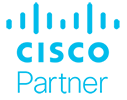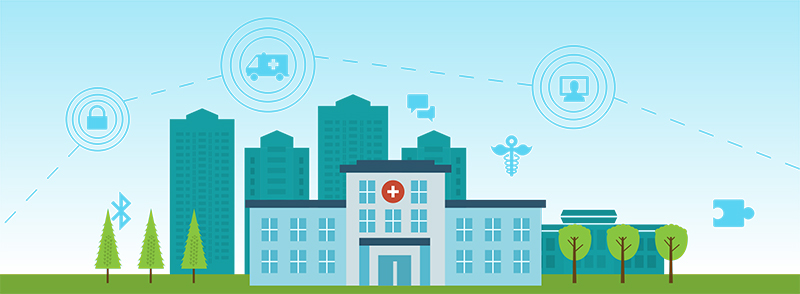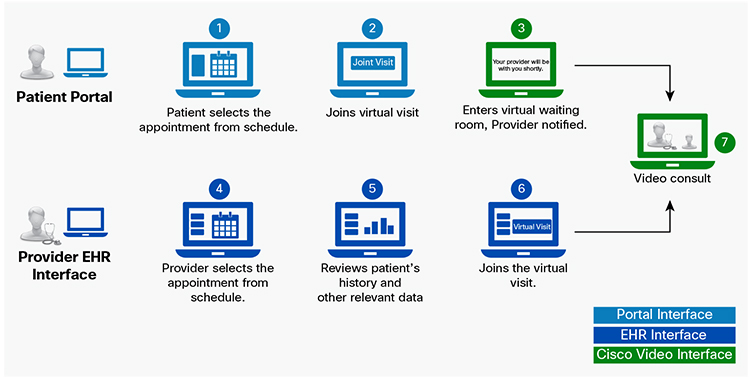
Cisco Blog
Welcome to the Cisco Blog.

Updating Healthcare Networks to Empower Better Care
Key aread for technology refresh help hospitals and clinics improve operations, increase data and application security, and deliver better patient care.
Healthcare networks are at a modernization turning point. Many are no longer able to deliver the performance, security, and services needed by current medical technologies, digitalized care practices, data growth, and security threats. Yet in a marketplace where patients and providers have higher expectations for the entire care experience, delivering superior network services can be a competitive advantage.
As an IT leader in a hospital, multisite healthcare system, or large clinic, you likely know the enterprise network is due for an update. Before launching a refresh program, you'll want a sensible strategy for choosing new solutions in order to reduce costs and risks as well as simplify the network infrastructure and management. Today, there are six key challenges facing healthcare organizations to consider when planning your technology refresh.
Keeping Pace with a Fast-Changing Healthcare Environment
The care demands and business operations of a connected healthcare environment are creating higher requirements for network services and performance:
- The biggest imperative is delivering appropriate and timely care to patients in a world where all of their records are digital. Network access to electronic health record (EHR) systems must be fast, available on mobile devices, and rock-solid reliable and secure.
- Network-connected medical equipment, from basic patient monitoring devices to sophisticated imaging systems, require more network bandwidth and services.
- More wireless devices are in use everywhere, as patients, visitors, and staff expect network access for their laptops, tablets, smartphones, and wearables. All these users and all these devices mean voice, video, and data must be able to stream simultaneously across a facility's network with high quality.
These requirements point to a refresh for both the wired and wireless network infrastructure. The wireless network in particular may be lacking in terms of speed and coverage, and older technology may not work effectively given a hospital's thick concrete walls and metal equipment that impact RF signal strength and coverage.
Cisco Solutions Provide a Foundation for Embracing Change
A smart refresh strategy will look at both the wired and wireless networks as well as network switches as part of a digital ready architecture approach.
The Cisco® Digital Network Architecture (Cisco DNA™) provides an open, softwaredriven platform that integrates critical innovations in networking software, such as virtualization, automation, analytics, and cloud, into one architecture. It frees your IT staff from time-consuming, repetitive network configuration tasks so they can focus instead on innovation that positively transforms your healthcare organization.
As part of this architecture, As part of this architecture, Cisco® Intelligent WAN (Cisco IWAN) integrates a comprehensive set of WAN traffic control and security features into Cisco routers used in the clinics, labs, physician offices, and other facilities of a multisite healthcare organization. integrates a comprehensive set of WAN traffic control and security features into Cisco routers used in the clinics, labs, physician offices, and other facilities of a multisite healthcare organization.
For the wireless network, Cisco 802.11ac wireless solutions provide a comprehensive, customizable Wi-Fi foundation that allows clinicians and other staff to access medical and business applications, and patients and visitors to access information services throughout a building or campus.
To support faster wireless connectivity, Cisco Catalyst® switches with multigigabit Ethernet technology deliver speeds beyond 1 Gigabit on existing Category 5e/6 cables.
A Cisco Digital Network Architecture Readiness Assessment Service identifies whether your network infrastructure is capable of handling the organization's increasing demands and provides recommendations to prepare the network for digital business.
Meeting the Expectations of Providers
Find a computer, log in, find the right record, make a mental note or printout, log out - only then is a physician or other clinician ready to make a care decision or talk to the patient. And that comes after waiting on the often slow screens of the Electronic Health Record (EHR) system running on a network that doesn't have adequate bandwidth. This scenario has been the reality of information and application access in most healthcare facilities. And this reality is increasingly frustrating to providers accustomed to the speed, ease, and convenience of using mobile devices.
Physicians and medical staff need to access images, lab reports, and clinical applications anywhere in the facility. They expect to use their familiar mobile devices, especially Apple iPhones and iPads. Meeting these expectations requires a wireless network that is optimized to support the latest mobile technologies.
Cisco Solutions for Delivering Better Service to Clinicians
Giving medical staff better ways to communicate and access information is at the core of all Cisco solutions for healthcare.
The demographics of providers are changing as digital-savvy millennials enter the workforce, yet hospitals and clinics need ways to easily share the knowledge and skill of more experienced providers. Cisco Collaboration in Healthcare solutions mean providers can locate and collaborate with the right specialists and care resources for patients using a choice of communications tools, including Cisco Telepresence™ and Cisco WebEx® for real-time conferencing, video and wireless technologies for image and data sharing, and Cisco Spark™ secure virtual rooms as an online team workspace.
Cisco and Apple have jointly developed Fast Lane technology that optimizes Cisco networks and iOS devices to work better together for voice and video calls, online meetings and collaboration sessions, and core healthcare and business apps.
Within the facility's core network, Cisco 802.11ac wireless solutions connect physicians and staff to information including bandwidth-intensive medical images. Mobility helps improve medical staff workflows and productivity as well as deliver up-to-the-minute patient health status from Wi-Fi enabled medical devices.
The Network Optimization Service optimizes the network and devices to help your network infrastructure operate with stability and peak efficiency.
Meeting the Expectations of Patients
Patients have become more actively involved in their care, and they seek more personalized and collaborative experiences with their providers and healthcare organizations. They expect EHR systems and other applications to operate with high performance so they don't have long wait times. Patients and visitors also expect to use their mobile devices to access care information and services from a hospital bed or waiting room.
Indeed, the quality of the network can affect a patient's perception of care quality, leading to lower scores on surveys that in turn may impact the facility's reputation, competitiveness, reimbursements, and profitability. The consulting firm Deloitte found that hospitals with high patient ratings have profit margins nearly three points higher than hospitals with low ratings1.
Cisco Solutions Help Enable Improved Services for Patients
A healthcare organization can give patients the quality consumer experience they expect from the Wi-Fi network itself as well as helpful mobility services.
The Cisco Connected Mobile Experiences (CMX) platform supports mobile patient services such as appointment check-in, real-time messaging, and wayfinding by using wireless location services, proximity technology, and mobile apps.
Cisco Mobility Experience Services offer hosted and managed mobility solutions for developing contextual, location-oriented applications and experiences. For example, these experiences can help patients find where they're going and deliver their records, quickly locate equipment, and simplify workflows to promote a smoothly functioning facility.
Protecting Devices and Data from Security Threats
In a healthcare network, there isn't just one weakest link-there are hundreds or even thousands. Those links are the connected medical devices used by patients every day, but which are sometimes delivered with vulnerabilities and minimal built-in security2.
If they are not adequately secured, connected medical devices can risk patient safety, provide an entry point for attack on the hospital network, or open a gateway to sensitive patient data and financial systems.
Another dimension of network security to consider is protecting data for patients, employees, and the business. Because they contain extensive personal information, medical records are worth more than credit card numbers on the black market. And healthcare, including electronic health records, has been named as the top target for cyber threats, including ransomware attacks that have the potential to significantly disrupt the facility's operations3.
In a time of increasing security threats and compliance requirements, a healthcare organization's security capabilities must span the entire spectrum of the enterprise network, including the data center, cloud connections, and all fixed and mobile endpoints. And that security must be ubiquitous across all sites, departments, and other organizational structures.
Cisco Solutions Focus on Strengthening Security End-To-End
Cisco security solutions offer the powerful combination of our experience in protecting large and complex enterprise networks and our knowledge of the unique security demands of healthcare organizations.
For example, Cisco Medical NAC segments medical devices and records on a converged wired and wireless network for implementing cybersecurity measures while reducing management costs and burden.
Another solution for segmentation, the Cisco TrustSec® software, dynamically organizes endpoints-including medical devices by type and model- into logical security groups that limit the impact of data breaches and compromised devices while reducing operational expenses and easing compliance efforts.
Internet connectivity is always a security concern. Cisco Umbrella provides a secure, cloud-delivered internet gateway with complete visibility into internet activity across all locations, devices, and users.
Some security capabilities are already built into a Cisco network. Network as an Enforcer features help you simplify regulatory compliance efforts by using centralized policies and network segmentation, especially to protect sensitive patient data. Network as a Sensor capabilities-including Cisco IOS® NetFlow, Cisco Stealthwatch, and the Cisco Identity Services Engine (Cisco ISE)-help you detect suspicious traffic, policy violations, and compromised devices within your environment.
Cisco Security Services help healthcare organizations develop and implement a strong strategy around security, compliance, and threat management.
Supporting Initiatives for Cost Control and New Services
There's no question: The network already plays a key role in improving the costeffectiveness of your medical services and business operations. A network refresh opens the way for even more effective initiatives to reduce costs and deliver new services.
For example, a single iPhone or iPad can replace the multiple devices carried by nurses and other care staff today (e.g., scanners, pagers, and phones). A full-coverage wireless network, combined with mobility services, can identify the real-time location of essential equipment, reducing the time spent by staff on tracking and helping to prevent theft.
Hospitals are increasing their telehealth offerings to control costs, increase patient satisfaction, and improve care outcomes. Telehealth visits are popular among patients because they can remain at home and conduct a video visit with a nurse, a primary-care physician, or a specialist. By giving patients the right medical devices and communication tools to use at home (or placing them in a skilled nursing or long-term care facility), a provider can check vital signs and update status through automatic data uploads and a quick voice or video call.
Figure 1. Personalized Collaboration for Healthcare at a Distance

Cisco Solutions Offer a Platform for Reducing Costs and Delivering New Services
Cisco offers a variety of solutions that address the dual challenge of reducing costs while also moving forward with innovative care services.
Cisco Extended Care integrates video into EHR portals, delivering the immersive video experience that makes a telemedicine session seem more like a face-to-face visit. This solution can support multiple participants and automatically launch the visit inside the Epic EHR system or any relevant workflow in a third-party portal solution.
By using the hospital network to streamline a service that is typically unreimbursed, Cisco Virtual Patient Observation allows trained staff in a central operations center to observe multiple high-risk patients through high-definition video surveillance and communicate directly to nearby caregivers.
In conjunction with a video surveillance system for physical security in your facilities, Cisco Video Surveillance Manager provides tools for tight integration into the network, including surveillance operations, management of video files, and a desktop manager for system displays.
And if the surveillance system itself is outdated, Cisco Meraki® physical surveillance products reduce the cost and complexity of traditional security camera installation, monitoring, and video storage.
A hospital can use the Cisco Connected Mobile Experiences platform to deliver location-based services for users and medical equipment, aggregate key RF and network information, and simplify Wi-Fi access for guests.
Your core phone system may also be an important part of the network refresh. Cisco Unified Communications Manager is a software-based voice and video telephony system that streamlines communications to reduce delays in patient care, support more efficient work, and reduce requirements for telephony hardware and infrastructure.
Capturing, Securing, and Delivering Data Everywhere
More devices are producing more data that will be accessed and analyzed by more applications and more users. Healthcare will embrace big data, smart devices, and the Internet of Things (IoT) for their advantages in improving care operations while also keeping costs in check.
Data is also essential for accurate metrics that show how your organization is fulfilling quality goals and accountable care contracts. Although the metrics may be presented as a simple number, calculating them requires collecting large amounts of data from many disparate sources, meaning the enterprise network must deliver adequate bandwidth and reach.
Data will become even more important to securely store and access as your organization adapts to two shifts. First, compensation models are shifting from fee-for-service to value-based care measures. Second, clinical practices are embracing more patient self-management of chronic conditions based on data delivered remotely to providers. Additionally, a new network must support continued compliance with regulatory standards for data access, including HIPAA and HITrust.
Cisco Solutions Keep Data Manageable
Virtualized servers and adaptable security are two solutions that help healthcare organizations address data growth.
Cisco Unified Computing System™ (Cisco UCS®) servers meet the stringent requirements of EHR and other healthcare systems for low latency and high availability.
Security monitoring becomes more complex as healthcare data and applications move to a mix of on-premises and cloud environments. Cisco Stealthwatch software uses telemetry data to detect suspicious or noncompliant device behavior to improve visibility, security, and response times for incidents across the network. The Stealthwatch Deployment Service helps you install, configure, tune, and integrate Stealthwatch into the network.
A Network That's Ready for a Changing Future
It is an ongoing challenge for healthcare IT: Find new ways to reduce costs while also enhancing information, communication, and decision-making across the continuum of care. More information and better access to it will help to streamline processes, eliminate waste, better manage resources, and make changes in care delivery that improve multiple dimensions of operations and medical services. Service integration with other organizations will also benefit from a network that has up-to-date scalability, flexibility, performance, and security.
Refreshing a healthcare network now will position your organization to keep pace with the challenges of today and be ready for new opportunities to come in care delivery and operational excellence.
Download the Updating Networks to Empower Better Care Data Sheet (.PDF)

